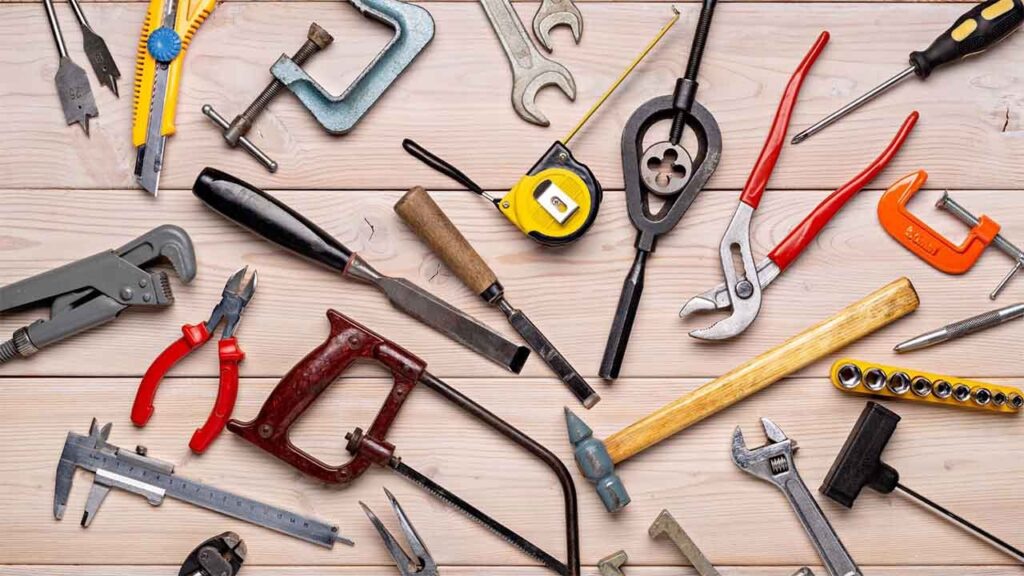Owning a home is a significant milestone but comes with many responsibilities. From minor repairs to major renovations, homeowners face a variety of tasks that require the right tools.
In 2024, having a well-equipped toolkit is more critical than ever, as modern homes incorporate new technologies and materials. This comprehensive guide will explore 20 essential tools that every homeowner should have, detailing their uses, features to look for, and tips for proper usage.
Whether you’re a first-time homeowner or have been maintaining your property for years, this article will help you build or update your toolkit for the challenges of home ownership in 2024.
We’ll cover everything from essential hand tools to more advanced power tools, ensuring you’re prepared for various home maintenance and improvement projects.
Let’s dive into the world of home tools and discover how they can make your life easier, save money, and help you confidently tackle projects.
1. Cordless Drill:
A cordless drill is the cornerstone of any home toolkit. In 2024, these devices have become more powerful, efficient, and versatile.
1. How to use it:
- Select the appropriate drill bit or driver for your task.
- Adjust the drill’s speed and torque based on the material and task.
- Hold the drill steady and apply even pressure while drilling.
- For driving screws, start slowly to avoid stripping the screw head.
2. Key features to look for:
- Lithium-ion battery for longer life and consistent power output
- Brushless motor for increased efficiency and longevity
- Multiple speed settings and adjustable clutch
- LED work light for better visibility in dark spaces
- A variety of drill bits and driver’s heads are included
3. Advanced uses:
With the right attachments, you can use a cordless drill for tasks like mixing paint, sanding, or even as a power screwdriver.
4. Maintenance tips:
- Keep the battery contacts clean
- Store batteries at room temperature
- Avoid completely discharging the battery
5. Safety considerations:
- Wear safety glasses to protect your eyes from debris
- Use the auxiliary handle for better control of high-torque tasks
- Be aware of what’s behind the surface you’re drilling into
2. Hammer:
A good hammer is indispensable for any homeowner. While it might seem simple, choosing the correct hammer and using it correctly can make a big difference in your projects.
1. How to use it:
- Hold the hammer near the end of the handle for maximum leverage and power.
- Strike the nail squarely on the head to avoid bending it.
- Use a smooth, controlled motion, letting the hammer’s weight do most of the work.
- Using the claw end and rock the hammer to remove nails to increase leverage.
2. Types of hammers:
- Claw hammer: Most common, suitable for general use and nail removal
- Ball-peen hammer: For metalworking and shaping metal
- Rubber mallet: For gentle tapping and assembly without marring surfaces
- Sledgehammer: For demolition work and driving stakes
3. Features to look for:
- Comfortable, shock-absorbing grip
- Proper weight balance
- Durable head material (like forged steel)
4. Maintenance:
- Keep the head clean and free of rust
- Check for loose heads on wooden handles
- Replace cracked or splintered handles immediately
5. Safety tips:
- Always wear safety glasses
- Ensure a firm grip, especially if your hands are sweaty or oily
- Never use a hammer with a loose head
3. Screwdriver Set:
A comprehensive screwdriver set is essential for countless household tasks. In 2024, screwdriver technology has evolved to include features like magnetic tips and ergonomic handles.
1. How to use it:
- Choose the correct size and type of screwdriver for your screw.
- Apply steady downward pressure while turning.
- For stubborn screws, use a little penetrating oil or wax on the threads.
- Keep the screwdriver straight to avoid stripping the screw head.
2. Types to include in your set:
- Flathead screwdrivers in various sizes
- Phillips head screwdrivers (#1, #2, #3)
- Torx screwdrivers (becoming more common in appliances and electronics)
- Robertson (square) screwdrivers
- Precision screwdrivers for small electronics
3. Features to look for:
- Magnetic tips for easier screw handling
- Comfortable, ergonomic handles
- Durable construction (chrome vanadium steel is a good choice)
- Storage case for organization
4. Advanced options:
- Multi-bit screwdrivers for versatility
- Ratcheting screwdrivers for faster work
- Electric screwdrivers for high-volume tasks
5. Maintenance:
- Keep tips clean and free of debris
- Store in a dry place to prevent rust
- Avoid using screwdrivers as pry bars or chisels
4. Tape Measure:
A reliable tape measure is crucial for any project involving measurements. Modern tape measures often include features like magnetic hooks and digital readouts.
1. How to use it:
- Pull the tape and lock it in place using the slide lock.
- For accuracy, keep the tape straight and taut.
- Read the measurement at the correct mark, noting both feet and inches.
- Add the width of the tape measure’s case to your reading for inside measurements.
2. Features to look for:
- At least 25 feet in length for most home projects
- Sturdy locking mechanism
- Clear, easy-to-read markings (some now include both imperial and metric)
- Durable blade coating to resist wear
- Strong belt clip for easy carrying
3. Advanced features:
- Magnetic hook for solo measuring of metal surfaces
- Finger brake for controlled blade retraction
- Built-in pencil sharpener
- Digital readout for precise measurements
4. Maintenance:
- Keep the tape clean and dry
- Allow the tape to retract slowly to prevent damage
- Replace if the tape becomes kinked or torn
5. Tips for accuracy:
- Use the “burn” technique: hook the end on your measuring point and “burn,” or use the actual measurement at the 1-inch mark for more accurate long measurements.
- For team measuring, agree on a consistent measuring method (e.g., inside edge or outside edge of the tape)
5. Level:
A level ensures that surfaces and objects are perfectly horizontal or vertical. In 2024, digital levels have become more common, offering precise angle measurements.
1. How to use it:
- Place the level on the surface you’re checking.
- Look at the bubble in the vial for a traditional bubble level.
- Adjust the object or surface until the bubble is centered between the lines.
- For vertical surfaces, use the plumb vial.
2. Types of levels:
- Spirit level: Traditional type with bubble vials
- Laser level: Projects a straight line over a distance, great for larger projects
- Digital level: Gives precise angle measurements, often with a backlit display
3. Features to look for:
- Multiple vials for horizontal, vertical, and 45-degree angles
- Magnetic edge for hands-free use on metal surfaces
- Shock-absorbing end caps to protect against drops
- Accuracy of at least 0.5mm/m
4. Advanced uses:
- Use a laser level for laying tile, hanging wallpaper, or installing chair rails
- Digital levels can help set precise slopes, like in plumbing applications
5. Maintenance:
- Keep vials clean for clear visibility
- Store in a protective case to prevent damage
- Periodically check accuracy by flipping the level and comparing readings
6. Utility Knife:
A utility knife is versatile for cutting materials like cardboard, rope, or drywall. Modern versions often feature ergonomic designs and tool-free blade changes.
1. How to use it:
- Extend the blade to the desired length, usually just enough to cut through your material.
- Hold the knife slightly to the cutting surface for better control.
- Use steady, controlled pressure and multiple passes for thick materials.
- Always cut away from your body.
2. Safety tips:
- Keep fingers clear of the cutting path
- Retract the blade fully when not in use
- Replace dull blades promptly – dull blades require more force and are more likely to slip
3. Features to look for:
- Comfortable, non-slip grip
- Easy blade change mechanism
- Blade storage in the handle
- Sturdy blade lock to prevent accidental retraction
4. Types of utility knives:
- Retractable blade: Most commonly, the blade retracts into the handle
- Fixed blade: For heavy-duty cutting, the blade doesn’t retract
- Snap-off blade: Long segmented blade, snap off dull sections for a fresh edge
5. Maintenance:
- Keep the blade channel free of debris
- Oil the blade change mechanism occasionally
- Store in a dry place to prevent rust
7. Pliers Set:
Pliers are essential for gripping, bending, and cutting various materials. A comprehensive set will prepare you for a wide range of tasks.
1. How to use it:
- Choose the correct type of pliers for your task.
- Grip the object firmly in the jaws of the pliers.
- For cutting, position the material as close to the pivot point as possible for maximum leverage.
- When bending wire or metal, use smooth, controlled motions to avoid weakening the material.
2. Types to include in your set:
- Needle-nose pliers: For reaching tight spaces and detailed work
- Channellock pliers: Adjustable for different sizes, suitable for pipes and nuts
- Diagonal cutting pliers (wire cutters): For cutting wire and small nails
- Lineman’s pliers: For heavy-duty cutting and gripping
- Locking pliers (Vise-Grips): For clamping materials
3. Features to look for:
- Comfortable, ergonomic handles with non-slip grips
- Hardened steel jaws for durability
- Spring-loaded handles for ease of use (on some types)
4. Maintenance:
- Keep the jaws clean and free of debris
- Oil the pivot point occasionally for smooth operation
- Store in a dry place to prevent rust
5. Safety tips:
- Wear safety glasses when cutting wire
- Be cautious of pinch points
- Don’t use pliers as a substitute for a wrench on nuts and bolts – they can damage the fasteners.
8. Adjustable Wrench:
An adjustable wrench is a versatile tool that can fit various nut and bolt sizes. It’s a space-saving alternative to a complete set of wrenches.
1. How to use it:
- Adjust the jaw to fit snugly around the nut or bolt.
- Position the wrench so that the force is applied to the fixed jaw, not the movable one.
- Turn the wrench in the direction you want to move the fastener.
- If the fastener doesn’t budge, try penetrating oil and let it sit before trying again.
2. Tips for effective use:
- Keep the adjustable jaw on the side you’re turning towards to prevent loosening during use.
- Avoid using it on tight fasteners; it can slip and damage them. Use a fixed wrench for these situations.
- Readjust the jaw frequently to ensure a snug fit as the fastener turns.
3. Features to look for:
- Wide jaw capacity
- Precise adjustment mechanism
- Durable construction (chrome vanadium steel is good)
- Comfortable, non-slip grip
4. Maintenance:
- Keep the adjustment mechanism clean and lightly oiled
- Avoid using it as a hammer or pry bar, which can damage the tool
- Store in a dry place to prevent rust
5. Safety considerations:
- Ensure the wrench is fully seated on the fastener before applying force
- Be aware of your hand position to avoid injury if the wrench slips
- Don’t use “cheater bars” or extensions to increase leverage, as this can damage the tool or the fastener
9. Allen Wrench Set:
Allen wrenches, also called hex keys, are used for fasteners with hexagonal sockets. They’re common in furniture assembly, bike repair, and many household items.
1. How to use it:
- Select the size that fits snugly in the fastener without wobbling.
- Insert the long end of the wrench into the socket for better leverage.
- Turn clockwise to tighten and counterclockwise to loosen.
- For extra torque, you can slip a pipe over the short end to extend your leverage (but be careful not to apply too much force).
2. Types of Allen wrench set:
- Individual L-shaped wrenches
- Folding multi-tool style
- T-handle sets for more torque
3. Features to look for:
- Full range of standard sizes (both metric and imperial)
- Durable construction (heat-treated steel is good)
- Comfortable grip for the larger sizes
- Storage case for organization
4. Maintenance:
- Keep wrenches clean and dry
- Check for signs of wear or rounding at the ends
- Replace individual wrenches as needed rather than the whole set
5. Use tips:
- Use the more extended arm of the L-shape for better leverage and the shorter arm for tight spaces
- Be careful not to strip the socket by using the wrong size wrench
- For stuck bolts, try using penetrating oil and let it sit before attempting to loosen
10. Flashlight:
A flashlight is essential for working in dark spaces or during power outages. LED technology has made modern flashlights brighter and more energy-efficient than ever.
1. How to use it:
- Keep batteries fresh or charge regularly if rechargeable.
- Use the focused beam for detailed work or inspection.
- Use the flood beam for area lighting or bounce the light off a ceiling or wall.
- Consider a headlamp for hands-free operation in tight spaces.
2. Features to look for:
- Multiple light modes (high, low, strobe)
- Adjustable focus (spot to flood)
- Water-resistant or waterproof design
- Long battery life
- Durable construction (aircraft-grade aluminum is good)
3. Types of flashlights:
- Handheld: Traditional style, versatile
- Headlamp: Hands-free operation
- Work light: Broader illumination for larger areas
- Tactical: Extremely bright, durable, often with special features
4. Advanced features:
- USB rechargeable battery
- Color temperature options (warm or cool light)
- Magnetic base for hands-free use
- Emergency SOS mode
5. Maintenance:
- Clean the lens regularly for maximum brightness
- Check and clean battery contacts
- Store without batteries if not used for long periods
- Keep o-rings lubricated on waterproof models
6. Safety tips:
- Avoid shining bright lights directly into the eyes
- Keep spare batteries or a backup light for emergencies
- Be cautious of heat buildup on high-power lights
11. Putty Knife:
A putty knife is a versatile tool for applying and removing putty, scraping, and light prying tasks. It’s essential for painting prep and many repair jobs.
1. How to use it:
- Hold at a 45-degree angle and spread evenly when applying putty or spackle.
- Hold the blade almost parallel to the surface for scraping and push firmly.
- Use the edge to get into corners and crevices.
- Clean the blade after each use to prevent buildup.
2. Types of putty knives:
- Flexible blade: Better for applying putty and smoothing surfaces
- Stiff blade: Better for scraping and prying
- Plastic blade: For delicate surfaces where metal might cause damage
3. Features to look for:
- Complete tang construction for durability
- Comfortable handle with good grip
- Rust-resistant blade
- Various widths (1″, 2″, 3″, and 4″ are common)
4. Advanced uses:
- Removing old caulk
- Applying and smoothing wood filler
- Scraping off old paint or wallpaper
- Light prying for removing trim or molding
5. Maintenance:
- Clean thoroughly after each use, especially with sticky substances
- Sand out any nicks in the blade edge
- Oil metal parts lightly to prevent rust
- Replace when the blade becomes too worn or bent
6. Safety tips:
- Be cautious of sharp edges, especially on metal putty knives
- Wear gloves when working with harsh chemicals or strippers
- Don’t use excessive force when prying to avoid damaging the tool or the surface
12. Caulking Gun:
A caulking gun is used to apply caulk to seal gaps around windows, doors, and bathrooms. It’s crucial for weatherproofing and preventing water damage.
1. How to use it:
- Cut the caulk tube nozzle at a 45-degree angle, matching the size of the gap you’re filling.
- Pierce the inner seal of the tube.
- Insert the tube into the gun and squeeze the trigger to puncture the seal if needed.
- Apply steady pressure while moving along the gap at a consistent speed.
- Smooth the caulk with a wet finger or specialized tool before it dries.
2. Types of caulking guns:
- Ratchet rod: Most common, suitable for occasional use
- Smooth rod: Allows for more precise control of caulk flow
- Electric: For large jobs or professional use
3. Features to look for:
- Thrust ratio of at least 10:1 for easy dispensing
- Rotating the barrel to maintain the optimal angle
- Built-in cut-off switch to stop caulk flow instantly
- Ladder hook for convenience when working at heights
- Comfortable grip for extended use
- Dripless design to minimize mess
4. Maintenance:
- Clean the gun thoroughly after each use, especially the plunger
- Oil moving parts occasionally for smooth operation
- Store in a clean, dry place to prevent rust
5. Tips for adequate caulking:
- Use painter’s tape on both sides of the gap for clean lines
- Work in temperatures recommended by the caulk manufacturer
- Cut the nozzle smaller than you think you need – you can always make it larger
- Practice on a scrap surface before tackling visible areas
6. Safety considerations:
- Wear gloves to protect your hands from the caulk
- Work in a well-ventilated area, especially with silicone caulks
- Be cautious of pinch points in the mechanism
13. Stud Finder:
A stud finder helps locate the wooden studs behind drywall. This is crucial for securely hanging heavy items and avoiding drilling into electrical wires or pipes.
1. How to use it:
Calibrate the stud finder according to manufacturer instructions, usually by placing it flat on the wall and pressing a button
- Move it slowly across the wall in a horizontal line
- Mark the edges of the stud when detected
- Confirm the stud location with a small nail or drill
2. Types of stud finders:
- Magnetic: Detects nails or screws in studs, more straightforward but less precise
- Electronic: More accurate, can detect different materials
- Multi-function: Can detect studs, live wires, and sometimes pipes
3. Features to look for:
- Deep scanning mode for thick walls
- Edge-finding capability for precise stud edge location
- Wire detection for safety
- LCD for easy reading
- Ergonomic design for comfortable use
4. Advanced uses:
- Locating floor joists
- Finding metal studs in commercial buildings
- Detecting breaks in materials (like checking for hollow spots in concrete)
5. Maintenance:
- Keep the sensors clean
- Replace batteries as needed
- Store in a dry place to protect electronic components
6. Tips for accurate readings:
- Start your search about a foot away from corners or doors
- Scan the wall multiple times for consistency
- Remember that studs are typically 16 or 24 inches apart
- Be aware that not all “hits” are studs – confirm before drilling
14. Safety Glasses:
Safety glasses protect your eyes from debris, dust, and splashes during DIY projects. They’re essential for any task involving power tools or potential eye hazards.
1. How to use it:
- Put them on before starting any project involving cutting, drilling, or chemicals
- Ensure they fit snugly but comfortably, with no gaps between the glasses and your face
- Use them in conjunction with a face shield for tasks with high debris risk
2. Features to look for:
- ANSI Z87.1 certification for impact resistance
- Anti-fog coating for clear vision
- UV protection for outdoor use
- Side shields for extra protection
- Adjustable arms for a custom fit
- Scratch-resistant lenses
3. Types of safety glasses:
- Over-the-glass (OTG) for those who wear prescription glasses
- Polarized for outdoor work
- Tinted for specific applications (like welding)
4. Maintenance:
- Clean them regularly with soap and water or lens cleaner
- Store in a protective case when not in use
- Replace them if they become scratched or damaged
5. Tips for comfort and effectiveness:
- Consider buying multiple pairs for different tasks
- Look for glasses with rubber nose pieces for extended comfort
- For dusty environments, consider sealed safety goggles
15. Work Gloves:
Work gloves protect your hands from cuts, scrapes, splinters, and chemical exposure. Different tasks require different types of gloves.
1. How to use it:
- Choose the right type for your task (leather for rough work, nitrile for chemicals, etc.)
- Ensure a snug fit for dexterity without being too tight
- Replace them when worn or damaged
2. Types of work gloves:
- Leather gloves: For heavy-duty tasks, suitable for handling rough materials
- Nitrile gloves: For working with chemicals, oils, and solvents
- Cotton gloves: For light tasks and better grip
- Cut-resistant gloves: For working with sharp tools or materials
- Insulated gloves: For tasks involving extreme temperatures
3. Features to look for:
- Reinforced palms and fingertips for durability
- Breathable materials to reduce sweat
- Touchscreen compatibility for use with digital devices
- Adjustable wrist closures for a secure fit
4. Maintenance:
- Clean according to manufacturer instructions
- Allow to dry completely before storage
- Store away from direct sunlight and heat sources
5. Safety considerations:
- Avoid loose-fitting gloves when working with power tools
- Be aware of allergies to materials like latex
- Know the limitations of your gloves (e.g., not all leather gloves are cut-proof)
16. Circular Saw:
A circular saw is versatile for making straight cuts in wood and other materials. It’s essential for more significant DIY projects like building decks or cutting plywood sheets.
1. How to use it:
- Mark your cutting line clearly
- Secure the material you’re cutting with clamps
- Set the blade depth to about 1/4 inch deeper than the material thickness
- Guide the saw steadily along the line, letting the saw do the work without forcing it
- Support the cut piece to prevent binding or kickback
2. Safety tips:
- Always wear safety glasses and hearing protection
- Keep hands away from the blade – use push sticks when necessary
- Unplug the saw when changing blades or adjusting
- Never remove or pin back the blade guard
3. Features to look for:
- Adequate power (at least 15 amps for corded, 18V for cordless)
- Blade brake for quick stops
- Dust blower to keep the cutting line visible
- Bevel adjustment for angled cuts
- Lightweight design for reduced fatigue
4. Maintenance:
- Keep the blade clean and sharp
- Check and tighten any loose parts regularly
- Lubricate moving parts as recommended by the manufacturer
- Store in a dry place to prevent rust
5. Advanced uses:
- With a guide rail, you can make long, perfectly straight cuts
- Special blades allow the cutting of materials like metal or tile
17. Voltage Tester:
A voltage tester is a safety tool to check if electrical circuits are live. It’s crucial for any electrical work to prevent shocks.
1. How to use it:
- Turn on the tester and check it on a known live outlet
- Touch the probe to the wire or outlet you’re testing
- Look for the light or sound indicating the voltage
- Always test both the hot and neutral wires
2. Types of voltage testers:
- Non-contact voltage tester: Detects voltage without direct contact
- Multimeter: More versatile, can measure voltage, current, and resistance
- Plug-in circuit tester: For quickly checking outlet wiring
3. Features to look for:
- Auto-shutoff to preserve battery life
- Visual and audible voltage indicators
- Rugged construction for durability
- Different sensitivity settings for various applications
4. Safety notes:
- Always assume a circuit is live until proven otherwise
- Use only on the voltage range the tester is designed for
- Test the tester on a known live circuit before each use
- Remember that the absence of voltage doesn’t always mean it’s safe to work on – lockout/tagout procedures are still important
5. Maintenance:
- Replace batteries promptly when low
- Keep the probes clean for accurate readings
- Store in a dry place to protect electronic components
18. Garden Hose:
A suitable garden hose is essential for outdoor tasks like watering plants, washing cars, and cleaning exterior surfaces.
1. How to use it:
- Connect securely to the water source
- Avoid kinking by unrolling thoroughly before use
- Use appropriate nozzles for different tasks
- Drain and store properly to prevent freezing in winter
2. Features to look for:
- Flexible, kink-resistant material
- The appropriate length for your yard (50 ft is typical for average yards)
- Sturdy, leak-proof connectors
- UV-resistant outer layer for durability
3. Types of garden hoses:
- Standard vinyl hose: Affordable but prone to kinking
- Rubber hose: More durable and flexible but heavier
- Expandable hose: Lightweight and compact when not in use
- Soaker hose: For efficient garden watering
4. Maintenance:
- Drain entirely after each use
- Store out of direct sunlight when not in use
- Coil loosely to prevent kinks and weak spots
- Replace washers in connectors if leaks develop
5. Tips for effective use:
- Use a hose reel for easy storage and to prevent tangles
- Consider a quick-connect system for easy attachment of nozzles and sprinklers
- In cold climates, bring the hose indoors or drain completely before winter
19. Ladder:
A sturdy ladder is necessary for reaching high places safely. It’s used for painting, cleaning gutters, changing light bulbs, and many other tasks.
1. How to use it:
- Place on a firm, level surface
- Extend fully and lock all mechanisms
- Follow the “three-point contact” rule: two feet and one hand, or two hands and one foot on the ladder at all times
- Don’t stand on the top two rungs of a stepladder or the top three rungs of an extension ladder
2. Types of ladders:
- Step ladder: For indoor use and lower heights
- Extension ladder: For outdoor use and greater heights
- Multi-position ladder: Versatile for various configurations
- Platform ladder: Provides a stable standing platform
3. Features to look for:
- Weight capacity appropriate for you and your tools
- Non-slip feet for stability
- Comfortable, wide rungs for extended use
- Lightweight yet durable materials (like aluminum or fiberglass)
4. Safety considerations:
- Inspect the ladder before each use for damage
- Never use a metal ladder near electrical sources
- Keep the ladder away from doorways or areas with foot traffic
- Don’t overreach – move the ladder instead
5. Maintenance:
- Clean after use, especially if exposed to paint or chemicals
- Lubricate moving parts occasionally
- Store indoors or under cover to protect from the weather
- Replace if there are any signs of damage or excessive wear
20. Shop Vacuum:
A shop vacuum, or wet/dry vacuum, is powerful enough to handle debris that regular vacuums can’t. It’s excellent for workshop cleanup, car detailing, and handling liquid spills.
1. How to use it:
- Choose the proper attachment for your task
- For wet pickup, remove the paper filter if it is present
- Empty and clean filters regularly
- Use caution when vacuuming liquids to avoid overflow
2. Features to look for:
- Large capacity tank (at least 5 gallons for home use)
- Powerful motor (look for high air watts or CFM ratings)
- Various attachments for different tasks
- HEPA filter option for fine dust
- Blower function for versatility
3. Maintenance:
- Empty the tank after each use
- Clean or replace filters regularly
- Check and clean the hose for clogs
- Lubricate wheels if they become squeaky
4. Advanced uses:
- Use as a blower for clearing leaves or drying cars
- Attach to power tools for dust collection
- Use for unclogging drains with the appropriate attachment
5. Safety tips:
- Don’t use hazardous materials unless specifically designed for it
- Be cautious of the power cord when moving around
- Wear a dust mask when vacuuming fine particles
Final thoughts
In 2024, every homeowner should have a well-equipped toolkit to handle various maintenance and improvement tasks. The right tools make home projects more manageable and efficient, from essential hand tools like hammers and screwdrivers to advanced power tools like cordless drills and circular saws.
Modern innovations, such as digital levels, LED flashlights, and advanced garden hoses, enhance the functionality and convenience of these tools. Safety gear, including safety glasses and work gloves, ensures you can tackle tasks without risking injury.
Regular maintenance of your tools ensures they remain in good working condition, ready for any project. By investing in these 20 essential tools, homeowners can save money, improve their DIY skills, and maintain their homes with confidence.









































